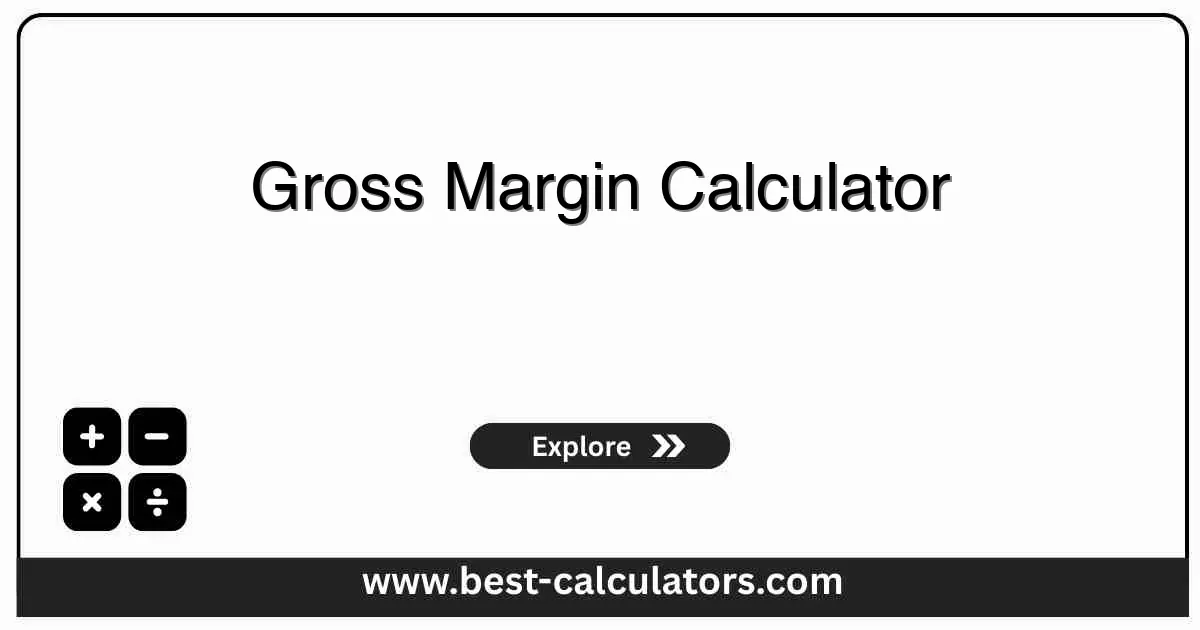Gross Margin Calculator - Calculate Business Profitability & Pricing Effectiveness
Free calculator to determine gross margin, gross profit, and pricing effectiveness for evaluating business profitability and cost efficiency
Gross Margin Calculator
Results
What is a Gross Margin Calculator?
A gross margin calculator is a free business tool that helps you calculate gross profit and margin percentages to evaluate business profitability. It determines how efficiently you convert sales into profits after deducting direct costs.
This calculator helps with:
- Profitability analysis - Measure how much profit each sale generates
- Pricing strategy - Determine optimal pricing for products and services
- Cost management - Identify opportunities to reduce direct costs
- Performance tracking - Monitor profitability trends over time
- Investment decisions - Evaluate which products offer best returns
Additionally, you can use our Breakeven Point Calculator to determine the sales volume needed to cover all your costs and start generating profit.
For calculating initial startup costs, check out our Startup Cost Calculator to estimate the total investment required to launch your business.
To understand the long-term value of your customers, utilize our Customer Lifetime Value Calculator to measure customer profitability over time.
How Gross Margin Calculator Works
The calculation uses the formulas:
Where:
- Revenue = Total sales income from products or services
- COGS = Direct costs of producing goods (materials, labor, manufacturing)
- Gross Profit = Profit after subtracting direct production costs
- Gross Margin = Profitability percentage of each sales dollar
Key Concepts Explained
Cost of Goods Sold (COGS)
Direct costs attributable to the production of goods sold including raw materials, direct labor, and manufacturing overhead.
Markup Percentage
The percentage difference between cost and selling price, calculated as (Profit / COGS) × 100.
How to Use This Gross Margin Calculator
Enter Total Revenue
Input total sales income from all products or services
Enter COGS
Input direct costs of producing goods or services sold
Calculate Results
View gross profit, margin percentage, and markup metrics
Analyze Findings
Compare results to industry benchmarks and previous periods
Benefits of Using This Calculator
- • Pricing Optimization: Determine optimal pricing strategies to maximize profitability while remaining competitive in the marketplace.
- • Cost Control: Identify areas where direct costs can be reduced to improve margins without sacrificing product quality.
- • Product Mix Analysis: Evaluate which products or services contribute most to profitability and adjust offerings accordingly.
- • Performance Benchmarking: Compare your gross margins to industry standards and competitors to assess competitive positioning.
- • Strategic Decision Making: Make informed decisions about product development, supplier negotiations, and business expansion opportunities.
Factors That Affect Your Results
1. Market Competition
Competitive pressures may force pricing concessions that directly impact gross margins, especially in commoditized markets.
2. Supplier Relationships
Negotiating power with suppliers and vendors significantly affects material costs and ultimately gross profitability.
3. Production Efficiency
Manufacturing processes, automation levels, and operational improvements can reduce COGS and increase gross margins.

Frequently Asked Questions (FAQ)
Q: What is a good gross margin for my business?
A: Good gross margins vary by industry. Manufacturing typically ranges from 30-60%, retail from 25-50%, and software/services from 70-90%.
Q: How often should I calculate gross margin?
A: Calculate monthly for performance tracking, quarterly for strategic planning, and annually for financial reporting and benchmarking.
Q: What costs are included in COGS?
A: COGS includes direct materials, direct labor, and manufacturing overhead. Exclude indirect costs like marketing, administration, and distribution.
Q: How can I improve my gross margin?
A: Increase prices, reduce material costs through better suppliers, improve production efficiency, eliminate low-margin products, and optimize product mix.
Q: What's the difference between gross margin and net margin?
A: Gross margin only deducts COGS, while net margin deducts all expenses including operating costs, taxes, and interest for a complete profitability picture.
Q: Why is gross margin declining despite increased sales?
A: Possible causes include rising material costs, pricing pressure, increased discounting, inefficient production, or shifting to lower-margin product lines.